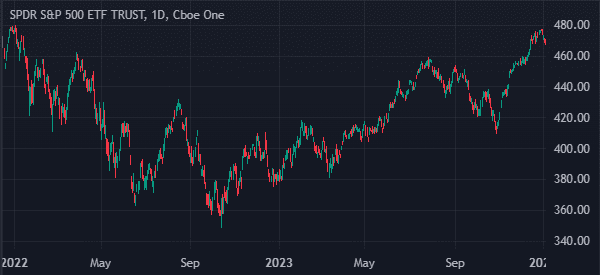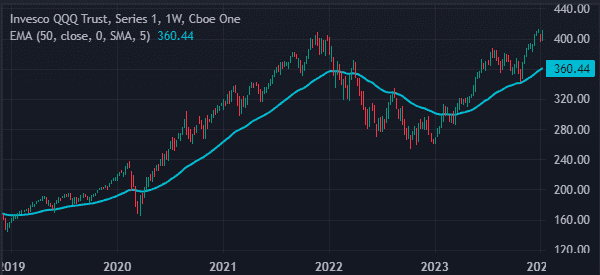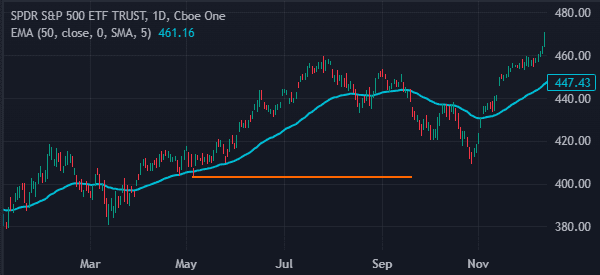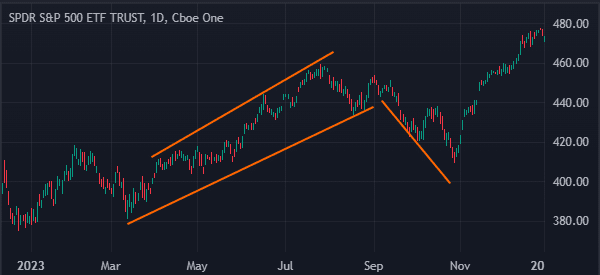A bull market is the best period in the financial market both for traders and investors alike. It is a period when most financial assets are in a strong uptrend as they form higher highs and higher lows.
The financial market has gone through many bull markets in the past. The most recent one happened after the start of the Covid-19 pandemic in 2020. While stocks and cryptocurrencies dipped early on, they staged a strong comeback, pushing them to record highs in 2021.
Another example of a bull market happened after the Global Financial Crisis (GFC) in 2009. While stocks crashed hard during the crisis, they staged a strong bull market that lasted until 2020.
A bear market, on the other hand, is the worst period in the market because it leads to substantial losses among long investors.
A good example of a bear market is what happened in 2022 as global central banks hiked interest rates. This article will explain how to trade profitably during a bull market.
Our intent is to explain the best bull market strategies. However, before we do this, we need to explain the characteristics and causes of this upward trend. If you already have this knowledge in your background, you can go directly to the strategies section.
Table of Contents
What is a bull market and how does it work?
A bull market is a period when the stock market is in a strong uptrend. In most cases, it is defined as a period when a major stock index like the S&P 500 and Nasdaq 100 rises by at least 20%.
A single stock, cryptocurrency, or commodity can also be said to be in a bull market when it rises by 20% from its lowest point in a period. A good example of a bull market is in the chart below.

As shown, the S&P 500 ETF (SPY) dropped to $341 in 2022. It then rose by 20% to $401 in February 2023 and pulled back. It finally confirmed the bull market re-entry in May 2023.
Characteristics of a bull market
Bull markets are not the same. However, in most cases, these markets tend to have several characteristics of qualities. Some of the most notable characteristics of a bull market are:
Steady uptrend
The first important characteristic of a bull market is that stocks tend to be in a steady uptrend. This is characterized by higher highs and higher lows as investors continually buy the dip.
This does not mean that there are no fluctuations, but that the overall trend is to rise up.
Pullbacks are common
The other characteristic of a bull market is that it has several pullbacks. A pullback is defined as a brief downtrend that happens when some traders start to take profits.
While a pullback is often brief, at times, it can go on for a few weeks. You must analyze them thoroughly to avoid entering a wrong trade.
Investor confidence
A bull market is also characterized by an increase in consumer confidence. There is usually a sense of optimism that the stock market will continue booming for a while.
As a result, institutional and retail investors tend to buy the winners.
Lower volatility
Further, a bull market tends to show lower volatility because of the limited market swings. The closely watched VIX index tumbled to a multi-year low in 2023 as American equities jumped.
Higher liquidity
A bull market is also characterized with high liquidity as large investors and retail traders allocate funds to stocks.
This situation is based on human psychology, where people tend to invest in assets that are climbing and vice versa. For example, brokerage companies like Robinhood and Interactive Brokers do well when stocks are soaring.
There are other characteristics of a bull market such as steady economic growth, generally dovish Federal Reserve, strong consumer confidence, and higher risk tolerance among investors.
Causes of a bull market
A common question is on what causes a bull market. While all bull markets are not the same, there are some popular causes, including:
Federal Reserve decisions
The biggest driver of a bull market in the US is the Federal Reserve. In most cases, bull markets happen two times.
First, they happen when the Fed is cutting interest rates. Equities and cryptocurrencies jumped after the Global Financial Crisis (GFC) and the Covid pandemic as the Fed slashed rates.
Second, it also happens when there is an expectation that the Federal Reserve will start cutting rates in the near future. A good example of this is in 2023 when stocks jumped as inflation dropped.
Economic boom
A bull market can happen when an economy is booming. This is characterized by low unemployment rate, growing wages, and low inflation. In this period, people tend to move their holdings to the stock market.
However, in some cases, a strong economy can slow a bull market since it implies that the Fed will start to hike rates. It does that in a bid to prevent the economy from having a hard landing.
Corporate earnings
A bull market is also caused by a sustained period of strong earnings growth. That growth leads to more optimism among traders, which leads to more inflows into stock.
In most cases, investors allocate more capital in companies showing strong earnings growth.
Black Swan event
The other catalyst for a bull market is often a black swan event, which is seen as a once-in-a-generation event.
While stocks tend to crash when such an event happens, they usually rebound sharply after that. We saw that during the Covid pandemic, dot com bubble, and the Global Financial Crisis.
Best Bull Market Strategies
Trend following
Trend following is one of the best approaches to trade in a bull market. It refers to a situation where a trader buys into an existing bull trade.
As such, if you see a stock constantly rising, and if the market conditions are conducive, you can buy and hold the asset for a while.
Traders use several approaches to prevent dramatic pullbacks. The most common one is to use indicators like moving averages and Bollinger Bands.
As shown below, a trader would have bought and held Invesco QQQ as long as it was above the 50-day Exponential Moving Average (EMA).

The other approach is to use trendlines. A trendline is a line that connects the lowest or highest swing in the market. In this case, you should buy and hold an asset as long as it is above the trendline.
Buying the dip
The other approach for trading in a bull market is to buy the dip. This is a situation where a trader waits for a pull back to happen and then buys. The idea is that the asset will resume its bullish trend again.
Like trend-following, you can do this by using trend indicators and trendlines. You will typically buy the asset when it hits the indicator and then wait for the trend to resume.
In addition to indicators, you can also use other tools like Andrews pitchfork and Fibonacci Retracement to predict when to buy the dip.
An example of buying the dip is shown below. In this case, you can buy the ETF when it retests the support at $399, which was an important swing.

Channel trading strategy
The other popular bull market trading strategy is known as the channel. It involves drawing two parallel lines that connect important low and higher swings.
In this case, the goal is to buy when the asset retests the lower side of the channel and short when it retests the upper side.
While the channel approach works well, it has its risks. The risk is where the asset continues rising after hitting its upper side. Also, it can continue falling when it moves below the lower side of the channel. An example of this channel is shown below.

News trading
Further, it is possible to use the news to trade during a bull market. This is a situation where you rely on the release of news to enter a position. There are two main types of news that you can use in the market: breaking and scheduled.
As the name suggests, breaking news refers to news that has not been expected by market participants. Examples include an analyst upgrade or downgrade, a CEO change, an activist investor entry, or a merger.
Scheduled news are those that you expect. The most common example of this is corporate earnings. In most cases, stocks tend to have big swings when they publish their financial results.
Traders use several approaches to trade the news. For example, some follow the trend while others fade it.
Scalping
Scalping is a trading strategy where a trader aims to make small profits several times per day. The goal is to take advantage of small upward trends and get out before they can have a reversal. For example, you can have a goal of making $10 per trade, 20 times per day.
Traders use several approaches to scalp. One of the best approaches is to use a technical indicator like the VWAP or moving average. In this, you will typically buy a stock when it moves above the indicator and vice versa.
Momentum
Momentum is a trading strategy that has a close resemblance to trend-following. The goal is to buy and hold financial assets that are showing momentum. To do this, traders rely on both trend indicators like moving averages and the Ichimoku cloud indicator.
The other approach is to use momentum indicators like the MACD, Relative Strength Index (RSI), Stochastic Oscillator, and the Rate of Change.
Chart and candlestick patterns
Further, traders use chart and candlestick patterns to trade during bull markets. These patterns can be classified into continuation or reversals.
When a continuation pattern forms, it is usually a sign that an asset will continue rising or falling. Reversal patterns signal that a new trend is about to form.
There are so many candlestick patterns, with the most popular ones being evening and morning star, bullish and bearish engulfing, hammer, and hanging man. Chart patterns include triangles, head and shoulders, wedges, and cup and handle.
Summary
In our article, we focused on the best strategies to profitably exploit a bull market. Not all of them focused on technical analysis.
But, to understand the best strategies, it is always helpful to keep in mind the characteristics and triggers of a bull market! Understanding the why and how of this sentiment also helps you choose the optimal solution.
External useful resources
- 3 Bullish technical trends to watch out for – Icici Direct





